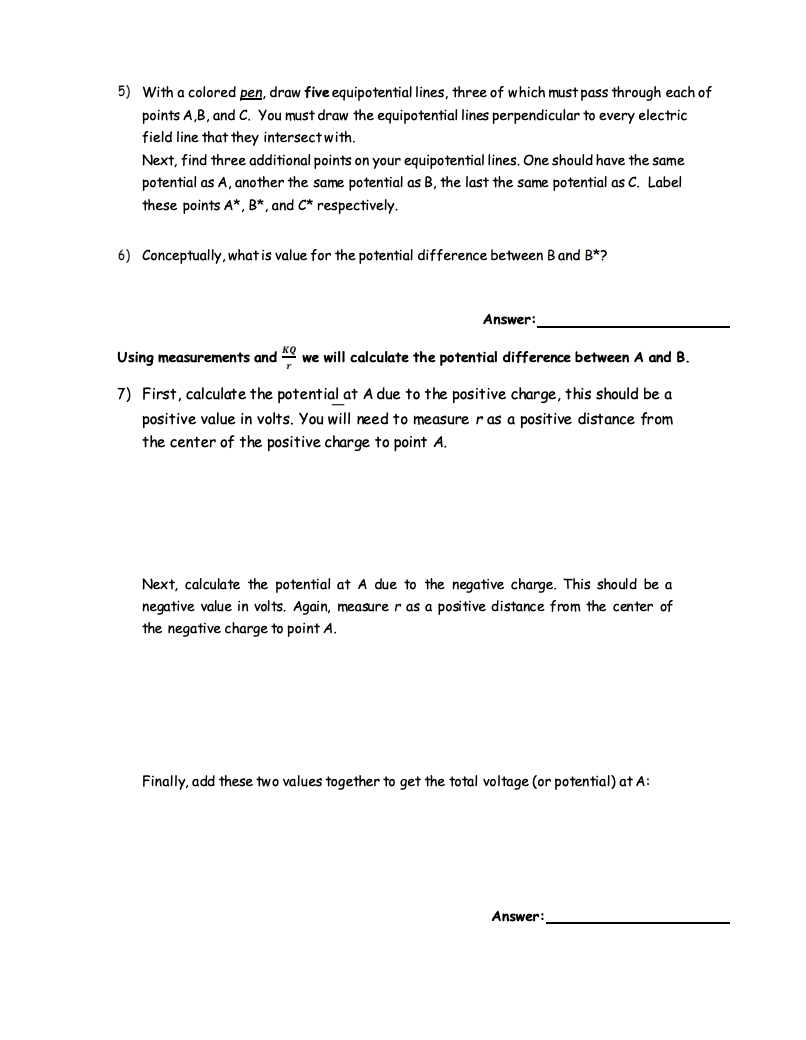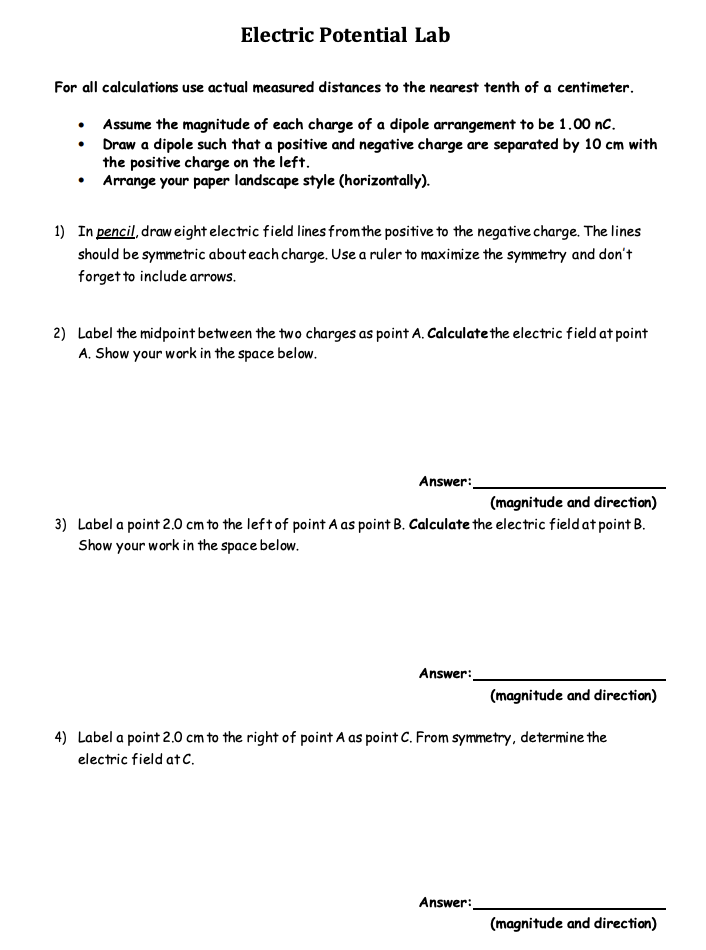5) With a colored pen, draw five equipotential lines, three of which must pass through each of points A,B, and C. You must draw the equipotential lines perpendicular to every electric field line that they intersectwith. Next, find three additional points on your equipotential lines. One should have the same potential as A, another the same potential as B, the last the same potential as C. Label these points A", B*, and C* respectively. 6) Conceptually, what is value for the potential difference between Band B*?
5) With a colored pen, draw five equipotential lines, three of which must pass through each of points A,B, and C. You must draw the equipotential lines perpendicular to every electric field line that they intersectwith. Next, find three additional points on your equipotential lines. One should have the same potential as A, another the same potential as B, the last the same potential as C. Label these points A", B*, and C* respectively. 6) Conceptually, what is value for the potential difference between Band B*?
Glencoe Physics: Principles and Problems, Student Edition
1st Edition
ISBN:9780078807213
Author:Paul W. Zitzewitz
Publisher:Paul W. Zitzewitz
Chapter21: Electric Fields
Section: Chapter Questions
Problem 103A
Related questions
Question
Please help with question 6

Transcribed Image Text:5) With a colored pen, draw five equipotential lines, three of which must pass through each of
points A,B, and C. You must draw the equipotential lines perpendicular to every electric
field line that they intersect with.
Next, find three additional points on your equipotential lines. One should have the same
potential as A, another the same potential as B, the last the same potential as C. Label
these points A*, B*, and C* respectively.
6) Conceptually, what is value for the potential difference between Band B*?
Answer:
Using measurements and
we will calculate the potential difference between A and B.
7) First, calculate the potential at A due to the positive charge, this should be a
positive value in volts. You will need to measure r as a positive distance from
the center of the positive charge to point A.
Next, calculate the potential at A due to the negative charge. This should be a
negative value in volts. Again, measure r as a positive distance from the center of
the negative charge to point A.
Finally, add these two values together to get the total voltage (or potential) at A:
Answer:

Transcribed Image Text:Electric Potential Lab
For all calculations use actual measured distances to the nearest tenth of a centimeter.
• Assume the magnitude of each charge of a dipole arrangement to be 1.00 nc.
• Draw a dipole such that a positive and negative charge are separated by 10 cm with
the positive charge on the left.
• Arrange your paper landscape style (horizontally).
1) In pencil, draw eight electric field lines fromthe positive to the negative charge. The lines
should be symmetric about each charge. Use a ruler to maximize the symmetry and don't
forget to include arrows.
2) Label the midpoint between the two charges as point A. Calculate the electric field at point
A. Show your work in the space below.
Answer:
(magnitude and direction)
3) Label a point 2.0 cm to the leftof point A as point B. Calculate the electric field at point B.
Show your work in the space below.
Answer:
(magnitude and direction)
4) Label a point 2.0 cm to the right of point A as point C. From symmetry, determine the
electric field at C.
Answer:
(magnitude and direction)
Expert Solution
This question has been solved!
Explore an expertly crafted, step-by-step solution for a thorough understanding of key concepts.
This is a popular solution!
Trending now
This is a popular solution!
Step by step
Solved in 2 steps

Knowledge Booster
Learn more about
Need a deep-dive on the concept behind this application? Look no further. Learn more about this topic, physics and related others by exploring similar questions and additional content below.Recommended textbooks for you

Glencoe Physics: Principles and Problems, Student…
Physics
ISBN:
9780078807213
Author:
Paul W. Zitzewitz
Publisher:
Glencoe/McGraw-Hill

Physics for Scientists and Engineers: Foundations…
Physics
ISBN:
9781133939146
Author:
Katz, Debora M.
Publisher:
Cengage Learning

Principles of Physics: A Calculus-Based Text
Physics
ISBN:
9781133104261
Author:
Raymond A. Serway, John W. Jewett
Publisher:
Cengage Learning

Glencoe Physics: Principles and Problems, Student…
Physics
ISBN:
9780078807213
Author:
Paul W. Zitzewitz
Publisher:
Glencoe/McGraw-Hill

Physics for Scientists and Engineers: Foundations…
Physics
ISBN:
9781133939146
Author:
Katz, Debora M.
Publisher:
Cengage Learning

Principles of Physics: A Calculus-Based Text
Physics
ISBN:
9781133104261
Author:
Raymond A. Serway, John W. Jewett
Publisher:
Cengage Learning

College Physics
Physics
ISBN:
9781938168000
Author:
Paul Peter Urone, Roger Hinrichs
Publisher:
OpenStax College